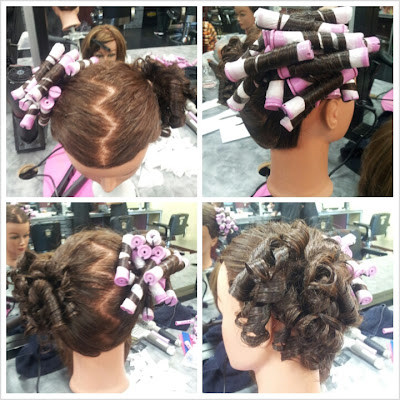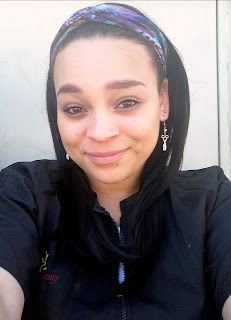Some women grow up getting perms and relaxers and others stumble upon it later into adulthood. These chemical processes are a huge commitment and very permanent. Perms and relaxers are similar but the end result is usually curly or straightened hair. They do this by breaking the disulfide bonds found in the protein of our hair strands. These chemicals are smelly and need maintained or retouched every so often resulting in an expensive habit.
My Background...
 |
| Freshly washed hair. |
There comes a point in a woman's life when she wants a change. I hit that point in my first 6 weeks of hair school. I allowed my class to do a relaxer on me as a demonstration. That was the last relaxer I had. I'm almost a year into my 2 year long term transitioning process. I cant wait to cut off what's left of my relaxer.
 |
| My hair has gotten longer and thicker over time. I had 2 inches cut off before taking the last photo. |
What It All Means...
Perm- A permanent wave is a process of adding curl to the hair using strong chemicals that break down bonds in your hair to shape your hair in its new curly form.
The Process:
- Shampoo
- Wrap
- Apply Chemical
- Process
- Rinse
- Dry
- Apply Neutralizer
- Rinse
- Remove Rods
- Style
 |
| Standard Perm Wrap |
 |
| Specialty Perm With Flexi Rods |
 |
| Partial Pigtail Spiral Perm |
Big Chop- Shortened to BC is when all of the relaxed hair is cut off at one time to reveal the natural hair beneath it. Some women shave their heads or chop it off after only a month. This can be a healthier and better option for some women. You really learn how to do your hair from its short stage. When its longer you will already know how to care for it.
Long Term Transition- The second option is to go through a lengthy transition process. For some people chopping all of their hair off just isn't an option and I was one of them. For every inch you grow you cut an inch and so on. Chopping a little at a time instead of all at once leaves you to deal with multiple textures in your hair. It is more challenging and calls for a ton of patience but is very do-able.
Transition Like A Boss
...
How Will You Transition...?Braid Extensions- You can braid or twist your hair with extension hair so that you have a lower maintenance transition. I suggest medium to large braids or twists to avoid breakage and stress on the hair growing in. Some smaller braids like micros braids have been known to break off the edges of hair in the front hairline. This can lead to permanent hair loss in the area.
Wigs/Hair Pieces- I transitioned using this method because it worked for me. You can buy different types of wigs to cover your hair or you can wear a phony pony tail. It all depends on how much coverage you are looking for. I'm a huge fan of half wigs!
Weaves- You can braid down or place a cap/net over the natural hair to add a full sew in weave or a quick-weave. This method did not work for me because it caused a lot of breakage in my hair from the cornrows. I don't recommend using this method for your entire transitioning process because the hair is always braided so small and tightly. It can effect your hair growth over time.
 |
| Before and after a full sew in weave. I had a to of breakage after taking it out. |
Best Wal-Mart Heat Protectants...
- CHI 44 Iron Guard
- TRESemme Heat Tamer
- Nexxus Heat Protexx
- Organix Brazilian Keratin Therapy Flat Iron Spray
- Aussie Hair Insurance
You can mix these methods or try each one to see what suites you best. You will have plenty of time to experiment through your journey. Just remember that no matter what you do you need to take care of your hair whether its underneath a wig or braided down for a weave. Don't neglect your hair just because it's out of sight. You can also transition for as long as you please and some women cut the rest of the relaxer off after about 9 months into it. Find what works for you and stick to it.
Learn more about the options above HERE in my Hair Extension Options blog post.
Maintenance...
Detangling- There are key ingredients to minimizing hair loss while detangling the hair. The average person can loose up to 200 hairs a day. When the hair is in its dry state it can collect the fallen hair inside of the style. When the hair gets wet or you start to manipulate it you will start to see hair loss.
To see a wad of hair in the brush afterward is nothing to be alarmed about because your just seeing all of your daily hair loss at one time. The only time to worry is if your seeing bald spots or losing patches/clusters of hair in one spot.
- Section the hair before attempting to detangle it. The smaller the section the easier it will be.
- Never comb dry hair.
- Stay away from rat tail or cutting combs. The close together teeth will pull and rip hair easier.
- Find a wide tooth comb and befriend it.
- Never brush wet hair.
- Take advantage of products by detangling the hair while it is loaded up with product.
- Use a product with "slip" meaning a product that makes running a comb through your hair easier.
- Detangle in the shower because the constant stream of water can make it easier.
- Use tools that make detangling easier like a TangleTeezer.
- Use your fingers to apply products, section your hair, and detangle your hair.
- Expect hair loss
Tips & Tricks
...
- Expect the unexpected... Do not go into this assuming you know everything because no matter how much you research and how many videos you watch or blogs you read you don't! Your hair will have a mind of its own. I am trained on doing hair and my hair teaches me something new every time I try to do it.
- Expect breakage... One thing you can rely on is breakage. Where your natural hair meets your relaxed hair is very weakened. Your hair is prone to snapping off right on that line. The longer your hair gets and the more you manipulate the hair the more likely it will happen. This is a big reason I don't love the idea of wearing small braids, weaves, or applying heat to your hair daily.
- Baby your locks... Take it easy on your hair during this period. The less you mess with it the better off you are. Protective styling is a great option and regular trims every 3-6 months are recommended. Try to avoid hair lightener like getting highlights because the bleach can cause damage to the hair.
- Avoid heat... Heat is probably one of the reasons your in need of a hair re-do. If you wear your hair straight sometimes the daily maintenance of your hair can include heat tools. It shocks me how many people do not use heat protectants on their hair. The heat causes breakage and alters your natural hair texture over time.
- Embrace protein... 90% of the hairs weight in its dry state is protein called keratin found in the cortex of the hair strand. This keeps the hair resistant against breakage. The chemical process weakens the hair after a relaxer. The relaxed hair will be weaker than your new growth which is what causes it to break off at that point. To strengthen the relaxed hair you need to add protein. Learn more about at home protein treatments HERE and learn more about your hair from the inside out HERE.
- Find what works... You will need to go through the trial and error with hair products to find what will work best for you. What works in a YouTube guru's hair may not work for your own. Don't break the bank trying products and more expensive isn't always better. Learn how to make at home hair treatments HERE to replace store bought expensive ones.
- Become aware... Read product labels and make online resources available to you. YouTube, beauty forums, Facebook, etc. are all great places to research products. You need to pay attention to the chemicals your putting into your hair. The less ingredients the better. Learn what to avoid and what to look for in the products you spend your money on. Find out why HERE.
- Take your time... Your hair while it is transitioning could take up a lot of time to maintain. To make it easier outside of the shower go the extra mile in the shower. Don't wash your hair to often and when you do use a sulfate free shampoo which you can learn more about HERE. Find a good conditioner and over use it. Deep condition often to add moisture to the hair as well.
- Co-wash... This has made one of the biggest differences in my hair. Co-washing is using only conditioner to wash your hair. Focus conditioner on the middle of your hair down. By applying it to your scalp your wasting product and your hair could be weighed down making your scalp look greasy.
- Moisture... Keep your hair hydrated weekly not daily. Relaxed hair can become water logged and break off if overly moisturized. It can't take as much moisture as your natural hair because of the difference in its porosity. Find out your own hairs porosity HERE.
- Section your hair... Before you do anything your hair will need to be in sections. It makes it easier to work with once it starts to become thicker. Applying products to the sections can increase their penetration and efficacy.
- Don't panic... Your new curl pattern is probably something you haven't had to deal with in a long time. You will not know your true curl pattern until you have cut off all of the relaxer and your hair is at least 3 inches long. The relaxed hair can add weight and pull out some of the curl causing a looser curl pattern. You need to give your hair some time and most importantly when you do see your true curl pattern you need to accept it and realize beauty comes in all different shapes.
- Try twist outs & braid outs... There's so many different ways to do these. They can be very time consuming but once you get the hang of it the results are worth it. One tip is to start off with damp hair and to mix a braid out with a twist out. 2 strand/flat twist the natural part of your hair and then cornrow or braid the relaxed portion of your hair. Use a flexi rod, straw, or perm rod to assure a curled end. The relaxed hair can be resistant against any texture but straight.

My first attempt at a twist out - Wrap your hair at night... Lay your edges down and protect the integrity of your hair at night so your morning maintenance is reduced. You will thank yourself later when your styles last longer, you win the battle against frizz, and you have less work to do in the morning.
Related Blog Post's...
My Hair Journey
Transitioning Hair Regimen
Keeping Hair Healthy









